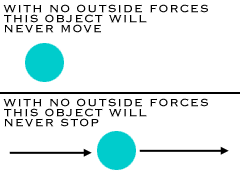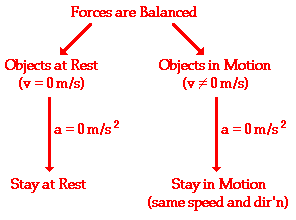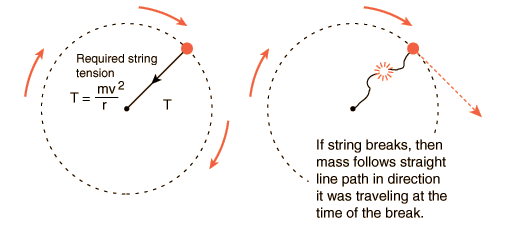Newton’s First Law of Motion:
Newton’s first law of motion is often stated as
An object at rest stays at rest and an object in motion stays in motion with the same speed and in the same direction unless acted upon by an unbalanced force.

Two Clauses and a Condition:
There are two clauses or parts to this statement – one that predicts the behavior of stationary objects and the other that predicts the behavior of moving objects. The two parts are summarized in the following diagram.

The behavior of all objects can be described by saying that objects tend to “keep on doing what they’re doing” (unless acted upon by an unbalanced force). If at rest, they will continue in this same state of rest. If in motion with an eastward velocity of 5 m/s, they will continue in this same state of motion (5 m/s, East). If in motion with a leftward velocity of 2 m/s, they will continue in this same state of motion (2 m/s, left). The state of motion of an object is maintained as long as the object is not acted upon by an unbalanced force.
All objects resist changes in their state of motion – they tend to “keep on doing what they’re doing. There is an important condition that must be met in order for the first law to be applicable to any given motion. The condition is described by the phrase “… unless acted upon by an unbalanced force.” As the long as the forces are not unbalanced – that is, as long as the forces are balanced – the first law of motion applies.
What do Force, External Force, and Net Force mean?
A force is a push or a pull exerted on one object by another object. The units of force F are called Newtons or simply N.
An external force is a force originating from outside an object rather than a force internal to an object. For instance, the force of gravity that Earth exerts on the moon is an external force on the moon. However, the force of gravity that the inner core of the moon exerts on the outer crust of the moon is an internal force on the moon. Internal forces within an object can’t cause a change in that object’s overall motion.
The net force, written as ΣF, on an object is the total force on an object. If many forces act on an object, then the net force is the sum of all the forces. But be careful—since force F is a vector, to find the net force ΣF, the forces must be added up like vectors using vector addition.
What does Mass mean?
The property of a body to remain at rest or to remain in motion with constant velocity is called inertia. Newton’s first law is often called the law of inertia. As we know from experience, some objects have more inertia than others. It is obviously more difficult to change the motion of a large boulder than that of a basketball, for example.
The inertia of an object is measured by its mass. Mass can be determined by measuring how difficult an object is to accelerate. The more mass an object has, the harder it is to accelerate.
Also, roughly speaking, the more “stuff”—or matter—in something, the more mass it will have, and the harder it will be to change its velocity, i.e., accelerate.
Centripetal Force Example:
The string must provide the necessary centripetal force to move the ball in a circle. If the string breaks, the ball will move off in a straight line. The straight line motion in the absence of the constraining force is an example of Newton’s first law. The example here presumes that no other net forces are acting, such as horizontal motion on a frictionless surface. The vertical circle is more involved.
Feedback is important to us.



